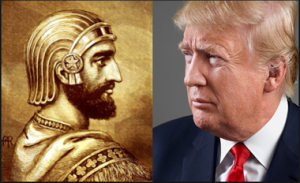 By: Amil Imani
By: Amil Imani
May 14, 1948, was the re-birth of Israel. The conditions surrounding Israel’s renewal was anything but simple. In fact, it was difficult. Israel’s journey from her early beginnings to the present has been fraught with great suffering. It is a tribute to the indomitable will and spirit of the Jewish people that they persisted in their valiant struggle to re-gather again in the land of their birth.
In ancient days, a noble and just Persian king, Cyrus the Great, rescued tens of thousands of Jewish people from captivity in a foreign land  and empowered them to return home and rebuild their sacred temple. By his action of freeing an entire people from captivity and restoring their rightful dignity and place in history, Cyrus the Great, the author of the First Code of Human Rights, cemented a bond of friendship between Jews and Persians.
and empowered them to return home and rebuild their sacred temple. By his action of freeing an entire people from captivity and restoring their rightful dignity and place in history, Cyrus the Great, the author of the First Code of Human Rights, cemented a bond of friendship between Jews and Persians.
Next year in Jerusalem was the wish of Diaspora Jews, dispersed from their homeland yet acknowledging their spiritual and historical home in Israel, specifically, Jerusalem. Psalm 137 referred to as the well-known lament of the Babylonian Jews who wept ‘by the rivers of Babylon’ and declared, ‘If I forget you, O Jerusalem, let my right-hand wither.” The perennial prayer, “Next Year in Jerusalem” has finally been answered.
Israel is a sovereign state but hardly safe. She is surrounded by nations and peoples who are bent on her destruction. It is tragic that her neighbors and she have not been able to find an equitable way of living side-by-side with mutual respect and in peace.
Jews have lived in the land of Israel for nearly 4,000 years, going back to the period of the biblical patriarchs (c.1900 BCE). The story of the Jewish people, Israel, its capital, Jerusalem, and the Jewish Temple there, has been one of exile, destruction and rebirth. We hardly can find countries that have gone out of existence for as long as 3,000 years and then reappeared and been reborn.
 From the moment of its rebirth, Israel through diplomatic channels with world leaders presented their historical case in order to return their ancestral homeland capital Jerusalem into the bosom of Israel. They asked for the recognition of Jerusalem as the official Capital of Israel. Back in 1995, the US Congress passed the so-called Jerusalem Embassy Act, proclaiming that Jerusalem “should be recognized as the capital of the State of Israel.” The act, however, also allowed the sitting president to delay the move by signing a waiver every six months. Bill Clinton, George W. Bush and Barack Obama all reissued the waiver throughout their presidencies, citing security concerns, even though during their respective campaigns promised to do so.
From the moment of its rebirth, Israel through diplomatic channels with world leaders presented their historical case in order to return their ancestral homeland capital Jerusalem into the bosom of Israel. They asked for the recognition of Jerusalem as the official Capital of Israel. Back in 1995, the US Congress passed the so-called Jerusalem Embassy Act, proclaiming that Jerusalem “should be recognized as the capital of the State of Israel.” The act, however, also allowed the sitting president to delay the move by signing a waiver every six months. Bill Clinton, George W. Bush and Barack Obama all reissued the waiver throughout their presidencies, citing security concerns, even though during their respective campaigns promised to do so.
Like Cyrus the Great, during the 2016 US presidential campaign, Republican candidate Donald Trump promised that, if elected, he would  relocate the US embassy from Tel Aviv to Jerusalem, describing the holy city as “the eternal capital of the Jewish people.” Trump’s declaration attracted a great deal of fervor within Israel and won over scores of Jewish and Evangelical voters in the US. By his benevolent action, many referred to President Trump as the second Cyrus the Great.
relocate the US embassy from Tel Aviv to Jerusalem, describing the holy city as “the eternal capital of the Jewish people.” Trump’s declaration attracted a great deal of fervor within Israel and won over scores of Jewish and Evangelical voters in the US. By his benevolent action, many referred to President Trump as the second Cyrus the Great.
During a speech at the White House on December 6, 2017, Trump said he had “determined it is time to officially recognize Jerusalem as the capital of Israel,” adding that the move was a “recognition of reality.” Trump cited the Jerusalem Embassy Act as one of the reasons behind his decision. “While previous presidents have made this a major campaign promise, they failed to deliver,” he said.
On March 25, 2019, the President even went further with bold action. On that day, he said: “The United States recognize the Golan Heights as part of Israel through a presidential proclamation signed by U.S. president Donald Trump on March 25, 2019.” President Trump’s obsession for the Persian monarch was obvious. For his compassion and brevity, many people have compared him to the ancient Persian monarch, Cyrus the Great.
© 2020 Amil Imani – All Rights Reserved





